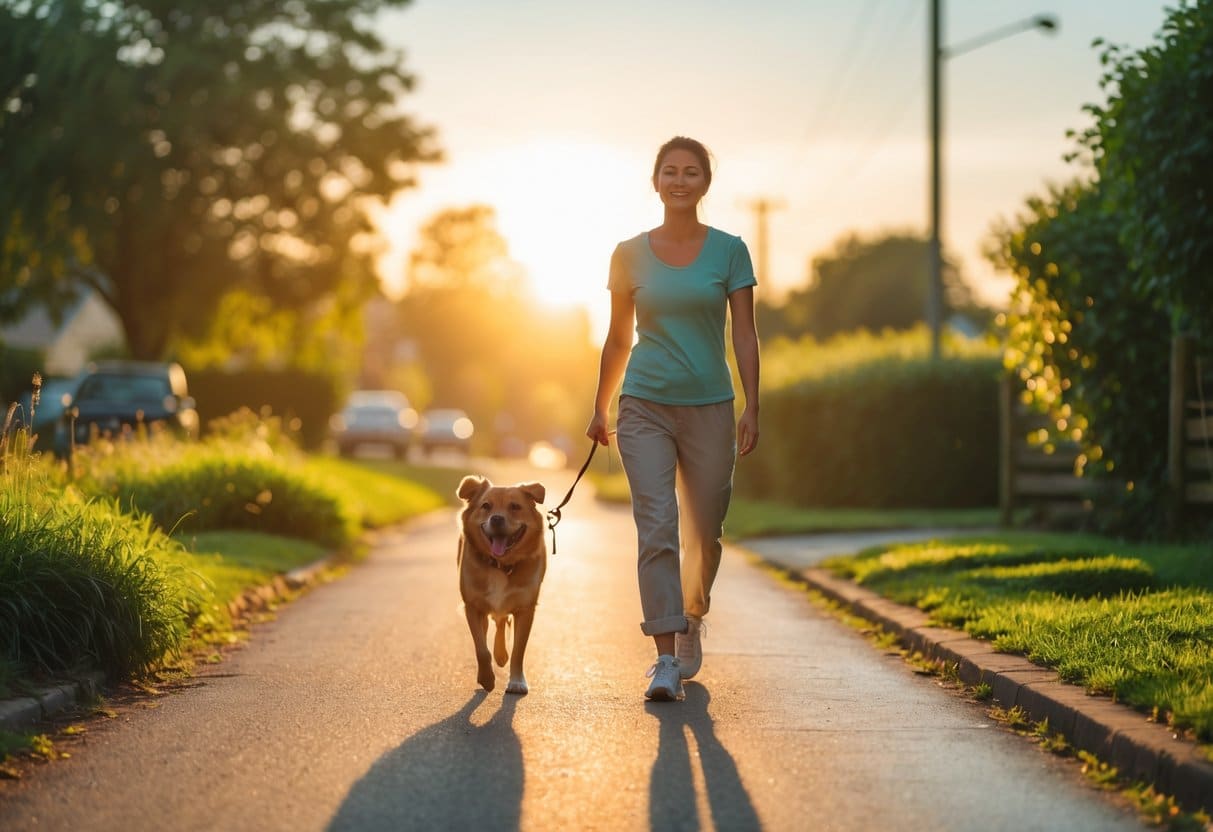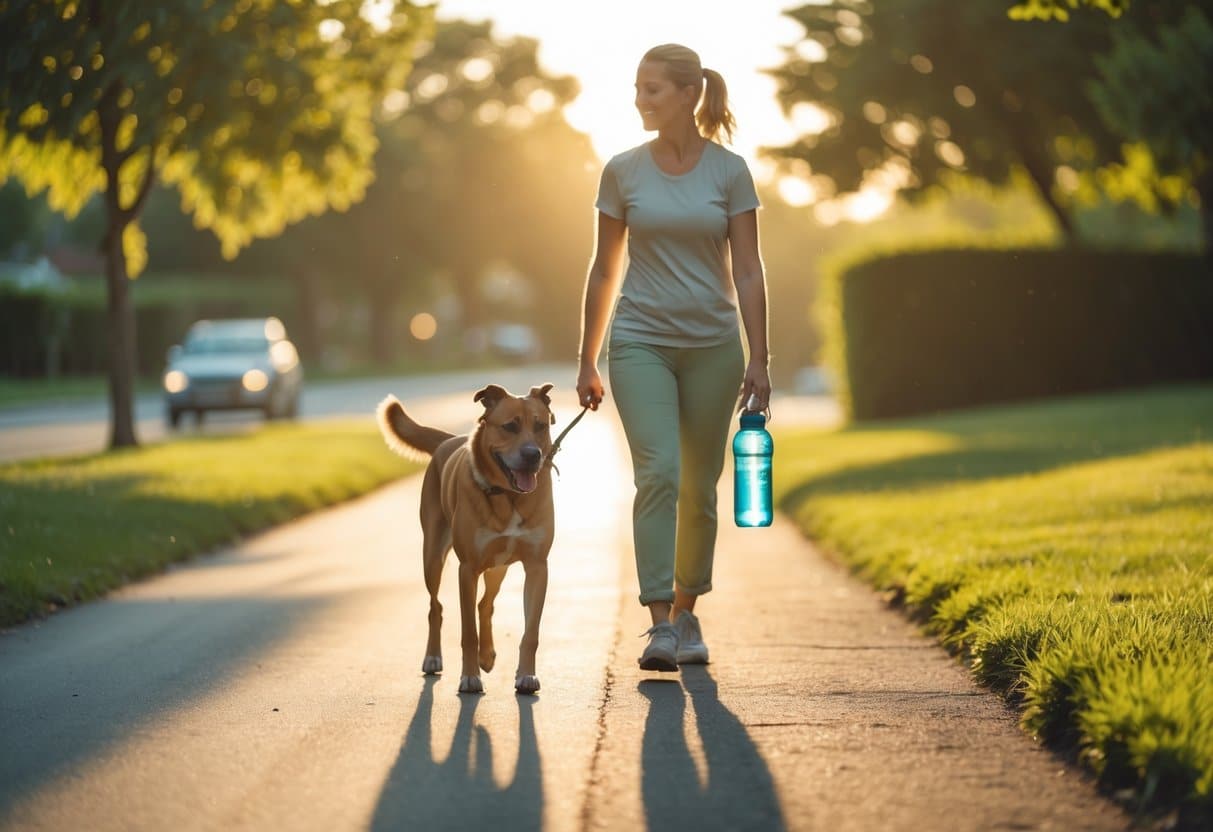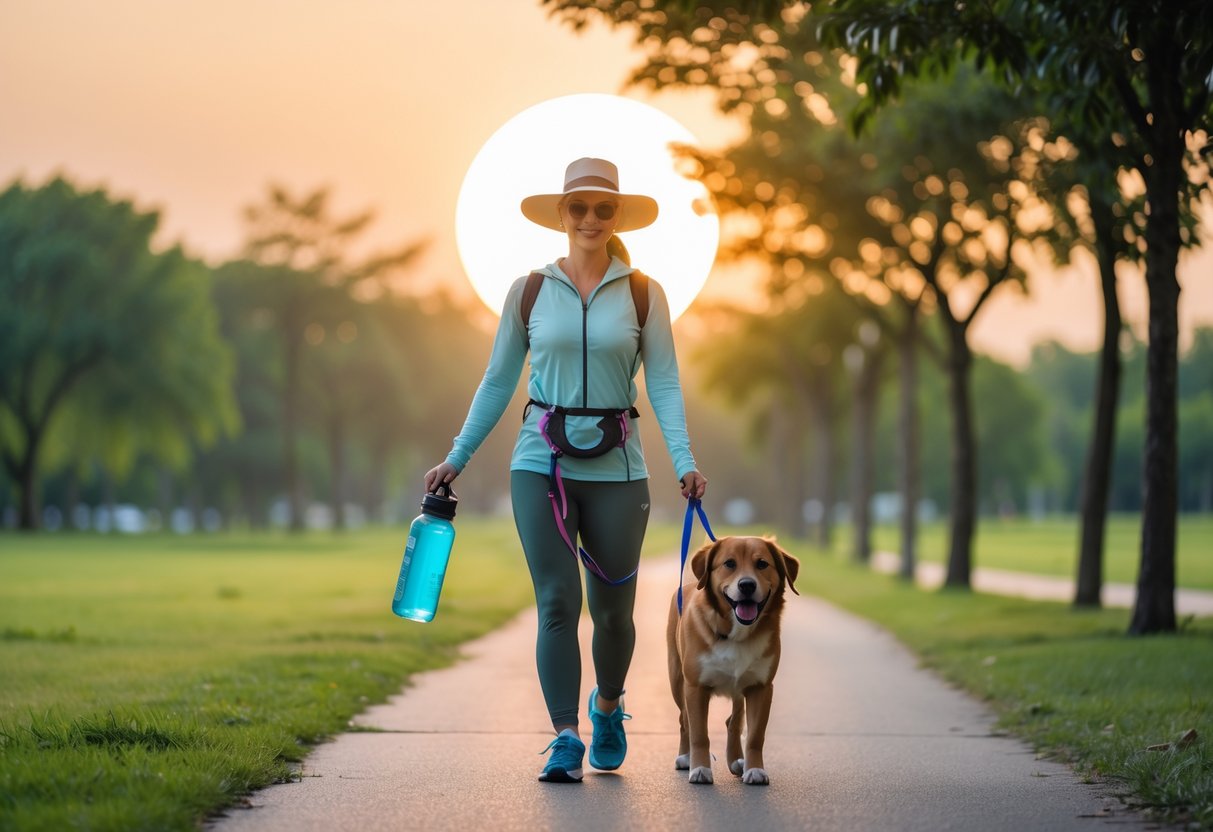
Summer heat can make daily dog walks risky if you pick the wrong time. High temperatures can mean overheating, burned paw pads, and dehydration.
The safest time to walk a dog in summer heat is during the early morning or late evening when the air and pavement are cooler. Those hours are just so much more comfortable for everyone—dog and human alike.
Walking during midday, especially between 10 a.m. and 4 p.m., can expose dogs to dangerous heat levels. Choosing shaded routes, carrying water, and checking pavement temperature before leaving can make a big difference.
Simple tweaks in your schedule and route really do keep dogs safe while letting them enjoy the outdoors.
Key Takeaways
- Walk during cooler early morning or late evening hours
- Avoid hot pavement and provide shade and water
- Adjust walk length and pace in extreme heat
Why Timing Matters for Summer Dog Walks
High outdoor temperatures can quickly raise a dog’s body heat, especially on sunny days with little shade. Hot pavement, direct sunlight, and humid air all boost the risk of dehydration, paw pad burns, and heat-related illness during walks.
Risks of Walking Dogs in Hot Weather
Walking dogs in hot weather can harm their health in several ways. Pavement and asphalt can heat to temperatures well above the air temperature, causing paw pad burns within minutes.
Dogs also face a higher risk of dehydration when exercising in the heat. Even short walks during midday can stress their bodies if they can’t cool down effectively.
The hottest hours—typically between 10 a.m. and 4 p.m.—are the most dangerous. According to PetMD, avoiding these peak times helps reduce the chance of overheating and paw injuries.
Choosing shaded, grassy routes can further protect them from excessive heat exposure.
Understanding Heatstroke and Overheating
Heatstroke happens when a dog’s body temperature climbs too high, often from being in the heat too long without enough cooling. This can happen so much faster than you’d think, especially if it’s humid.
Common signs include:
- Excessive panting
- Drooling
- Weakness or stumbling
- Bright red gums
- Vomiting or collapse
If heatstroke is suspected, move the dog to a cool area right away, offer small amounts of water, and use wet towels to help cool them. Veterinarians warn that untreated heatstroke can be life-threatening.
Short-nosed breeds, older dogs, and those with thick coats are at higher risk. For them, even moderate heat can trigger symptoms quickly.
How Dogs Regulate Body Temperature
Dogs cool themselves mostly by panting and a bit by sweating through their paw pads. They don’t have the same sweat glands we do, so they’re not great at shedding heat through their skin.
Panting moves air over moist surfaces in the mouth and respiratory tract, helping evaporate heat. But if it’s really hot or humid, even panting doesn’t work as well as it should.
Because of this, walking dogs in hot weather can raise their core temperature fast. Breeds with short muzzles—think pugs and bulldogs—have an even tougher time cooling down, so sticking to cooler morning or evening walks is just safer for them.
Best Time of Day to Walk a Dog in Summer Heat
Dogs face higher risks of overheating when temperatures rise, especially on sunny days with little shade. Choosing cooler times of day and safe walking surfaces helps prevent paw burns, dehydration, and heat-related illness.
Early Morning Walks: Benefits and Tips
Early morning, usually before 8 a.m., brings the coolest outdoor temps of the day. Overnight, the pavement and air have a chance to cool down, which means less risk of paw burns.
Morning walks let dogs get their energy out before the sun gets intense. This is a big deal for brachycephalic breeds, older dogs, and those with thick coats.
Owners can check pavement safety with the 7-second test—just press the back of your hand to the ground for several seconds. If it’s hot for you, it’s too hot for your dog.
Carrying water and letting your dog have small, frequent sips keeps them hydrated. A collapsible bowl is easy to bring along, so why not?
For longer walks, shaded parks or tree-lined streets are lifesavers. Trees just make everything better in summer.
Late Evening Walks: What to Consider
Evening walks after 7 p.m. can be safe once the sun is low and the pavement has cooled. But honestly, in some places, concrete and asphalt hold heat for hours.
Testing the ground temperature before heading out is always smart. Shaded trails, grassy fields, or dirt paths are way better than sidewalks or parking lots.
Lighting’s a thing, too. Reflective gear for both you and your dog helps drivers see you. A little clip-on light for the leash or collar doesn’t hurt either.
Watch for mosquitoes and bugs at dusk. If needed, use vet-approved insect repellents made for dogs.
Keep evening walks moderate in length so your dog gets some fresh air without getting overtired at the end of the day.
Times to Avoid: Midday and Peak Heat Hours
Midday, especially between 10 a.m. and 4 p.m., is the hottest and most dangerous time for dogs in summer. Pavement can get over 140°F—hot enough to burn skin in seconds.
During these hours, dogs are more likely to develop heat exhaustion or heatstroke. Signs include heavy panting, drooling, and weakness.
If you absolutely have to go out, keep it to quick bathroom breaks in the shade. Always have fresh water ready before and after.
Try indoor games like fetch in the hallway or some scent work if your dog’s got energy to burn. No need to risk it outside during peak heat.
For more safety guidance, check out these summer dog walking tips from veterinary experts.
Protecting Your Dog’s Paws in Hot Weather
High temperatures can make pavement, sand, and other surfaces hot enough to burn a dog’s paw pads. Even short walks on unsafe surfaces can cause pain, blisters, or injury.
Choosing the right walking conditions and using protective gear can prevent these problems.
Checking Pavement and Surface Temperatures
Hot pavement can reach dangerous temperatures even when the air feels warm but not extreme. For example, if it’s 86°F outside, asphalt might be about 135°F—enough to burn skin within seconds.
A simple way to test is the “7-second rule”: put the back of your hand or bare foot on the surface for 7 seconds. If it feels too hot, skip that route.
This check works for asphalt, concrete, sand, metal, and artificial turf, since all can heat up fast. Even dirt can get uncomfortably hot in full sun.
Walking during cooler times of day lowers the risk, but always test the ground first. More on safe temperature guidelines is available from the American Kennel Club.
Choosing Safe Walking Routes
Selecting shaded or grassy areas helps protect paws from heat. Grass is almost always cooler than hard surfaces and less likely to cause burns.
Tree-lined streets, shaded trails, and parks with natural ground coverings are good options. Avoid long stretches of exposed pavement or parking lots.
If shade is limited, try alternating between grass and pavement to reduce heat exposure. Carrying your dog for short sections might be necessary for small or sensitive breeds.
Early morning or late evening walks offer cooler conditions, but route choice still matters. Sometimes, surfaces hold heat longer than you’d expect.
Using Dog Booties for Paw Protection
Dog booties create a barrier between paws and hot ground. They’re especially handy when you can’t find shade or grass.
Booties should fit snug but not be tight. Look for breathable materials with non-slip soles for traction—nobody wants a dog skidding around. Skip adhesive products that stick right on the paw pads.
Some dogs need time to get used to wearing booties. Try a few short practice sessions indoors before venturing out.
Good booties also come in handy for rough terrain, sharp objects, or even winter ice. The summer styles are usually lighter and designed to help keep paws cool, so they’re worth a look.
Hydration and Heat Safety Essentials

Dogs lose water faster in hot weather, especially when they’re active. High temperatures can push them toward heat stress pretty quickly if you’re not paying attention to hydration.
Simple prep before heading out goes a long way to keep dehydration and heat illness at bay.
Carrying Water and Portable Bowls
Always bring fresh, cool water on summer walks. Collapsible silicone bowls or lightweight bottle-bowl combos are handy and easy to stash.
Offer water in small sips to avoid upsetting your dog’s stomach. Avoid relying on public water sources; they’re often empty or, honestly, not that clean.
Pet stores sell bottles with built-in troughs that let dogs drink without a mess. Pick a size that fits your walk—no one wants to run out halfway through.
| Walk Length | Recommended Water Amount |
|---|---|
| Under 30 min | 250–500 ml |
| 30–60 min | 500–750 ml |
| Over 1 hour | 750 ml–1 L |
Recognizing Dehydration in Dogs
Early dehydration shows up as dry gums, thick saliva, and skin that doesn’t bounce back if you pinch it at the neck. That skin test? Just pinch gently—if it’s slow to go back, your pup needs water.
Lethargy, less appetite, and sunken eyes are other red flags. In bad cases, dehydration can lead to collapse or shock, and that’s a straight-to-the-vet situation.
Dogs with thick coats, flat faces, or health issues are especially at risk when it’s hot. Keep a closer watch on them during walks.
Mental checklists of symptoms help spot trouble before it gets serious. The vet-approved summer walking tips have more details if you’re curious.
Offering Water Breaks During Walks
Offer water every 15–20 minutes when walking in the heat. Frequent, small breaks keep your dog hydrated without causing bloat.
Shady spots work best for water stops—they help cool things down, too. If your dog won’t drink, take a pause and watch for any signs of overheating before moving on.
Some dogs are picky—they’ll drink more if the water’s cool (but not icy). Toss a couple ice cubes in your bottle before you go; it helps.
Gear and Precautions for Summer Walks

Dogs get a lot out of gear that keeps them cool, blocks UV rays, and keeps them safe on adventures. The right equipment makes a real difference on hot days.
Cooling Vests and Bandanas
Cooling vests and bandanas use evaporative cooling. Soak the fabric in cool water, wring it out, and let your dog wear it—it’ll help them release heat as it dries.
Make sure the vest fits well: it should cover the chest and back, but your dog still needs to move freely. Most brands use light, breathable fabrics.
Re-wet the vest or bandana as needed if you’re out for a while. On those scorchers, pair cooling gear with lots of shade and keep walks short.
Reflective strips on some vests add visibility, which is handy during dawn or dusk strolls.
Dog-Friendly Sunscreen and UV Protection
Light-coated, thin-furred, or exposed-skin dogs can burn—especially noses, ears, and bellies. Use pet-safe sunscreen, like the ones in these summer dog walking tips, before heading out.
Avoid human sunscreens with zinc oxide or salicylates—they’re toxic if licked. Stick with products labeled for dogs.
UV-protective clothing like lightweight shirts or visors can help shield sensitive spots. Dogs with skin issues or medical conditions might need both sunscreen and UV-blocking gear.
Remember to reapply sunscreen after swimming or if your dog’s panting a lot—it wears off faster than you’d think.
Leashes, Harnesses, and Identification
A secure leash and harness are must-haves for busy or new places. In summer, pick a breathable harness—mesh or padded nylon beats heavy materials for airflow.
Harnesses spread out pressure, which is better if your dog pulls or needs gentle handling. Reflective stitching and bright colors help with visibility when it’s dim.
Always keep ID tags up to date, with your current phone number. Microchips add peace of mind if your dog’s a runner or gets distracted easily.
A hands-free water bottle holder is a nice touch—keeps your hands free for the leash and lets you carry water for both of you.
Special Considerations for At-Risk Dogs
Some dogs just aren’t built for heat—think certain breeds, older pups, or those with health issues. They need shorter walks, cooler conditions, and a bit more TLC in summer.
Flat-Faced and Heavy-Coated Breeds
Pugs, Bulldogs, Frenchies—flat-faced breeds—have short airways that make cooling off tough. Even a little heat can be too much.
Thick-coated dogs like Huskies, Newfoundlands, and Collies hold onto body heat. Their fur traps warmth, especially when it’s muggy.
Try to:
- Stick to cooler hours for walks
- Find shade and plan for plenty of pit stops
- Use cooling vests or bandanas
Vet-approved summer safety advice suggests grassy paths over asphalt—they’re easier on paws and keep dogs cooler.
Senior Dogs and Puppies
Older dogs can’t handle heat as well and tire out faster. They also bounce back slower from heat exposure.
Puppies are still learning how to deal with temperature swings. They might play too hard before realizing they’re overheating.
Keep in mind:
- Shorten walks when it’s hot
- Offer water every 10–15 minutes
- Pick shaded, low-impact routes
Both seniors and puppies may need extra time to cool off indoors after a walk. Collapsible water bowls are a lifesaver for quick hydration breaks.
Dogs with Health Conditions
Dogs with heart disease, breathing problems, or who are overweight struggle more in the heat. Their bodies work overtime just to stay cool.
Conditions like laryngeal paralysis or tracheal collapse make things worse. Overheating can sneak up fast with these pups.
What helps:
- Check with your vet before planning summer exercise
- Keep walks short and easy
- Watch closely for early heat stress, like excessive panting or weakness
Some meds mess with hydration or heat tolerance, so double-check with your vet. Professional advice like Ask A Vet can help set safe limits.
Alternatives and Adjustments for Extreme Heat
When it’s sweltering, dogs can overheat before you know it. Limiting time outside, picking safer environments, and watching for early warning signs are key to avoiding heat illness.
Shorter Walks and Indoor Activities
On brutal days, keep walks super short. Early morning or late evening, 5–10 minutes might be enough for a bathroom break, and that’s okay.
Asphalt can get dangerously hot—if you can’t hold your hand on it for five seconds, it’ll burn your dog’s paws. Stick to grass or shaded dirt paths when you can.
Swap longer outdoor walks for indoor play. Hallway fetch, tug-of-war, or puzzle toys keep dogs busy without risking heat exposure.
Cooling gear like damp bandanas or mats can help for quick outings. They work best with limited sun and lots of water breaks.
For more inspiration, check out these indoor dog activity suggestions to keep your pup happy when it’s too hot to go out.
Recognizing When to Skip Outdoor Walks
Sometimes, it’s just too hot—skipping the walk is the safest move. If the heat index is through the roof, even quick walks can be risky.
Temps above 90°F, high humidity, and no shade? That’s a no-go, especially for flat-faced breeds, seniors, and dogs with health problems.
If your dog’s panting hard, drooling, or slowing down, stop right away and get them to a cool spot.
Indoor exercise or a trip to an air-conditioned, dog-friendly place is a better bet on those days. According to expert walking tips, changing routines during heatwaves is critical to prevent heatstroke.
Frequently Asked Questions
Hot weather can quickly create unsafe conditions for dogs, especially during summer walks. Temperature, pavement heat, and humidity all play a role in determining when it’s safe to go outside.
Knowing the signs of overheating and adjusting walk times can help reduce the risk of heat-related problems.
What are the signs that it’s too hot outside for walking my dog?
Dogs may show signs of heat stress like heavy panting or drooling.
If your dog seems sluggish or just doesn’t want to walk, that’s another clue. When the air feels stifling or shade is scarce, it’s probably not a good idea to head out.
How can I tell if the pavement is too hot for my dog’s paws during summer walks?
Try placing the back of your hand on the pavement for about five seconds. If it’s too hot to keep it there, it’s definitely too hot for your dog’s paws.
Honestly, choosing grassy or shaded routes feels like a no-brainer to help protect those paw pads.
Is it better to walk my dog early in the morning or late in the evening during hot weather?
Walking during cooler hours—like early morning or after sunset—just makes sense.
According to PetMD, these times mean less intense sun and cooler surfaces underfoot.
At what outdoor temperature should I avoid walking my dog to prevent heatstroke?
Many vets say to skip walks when it’s around 85°F (29°C) or hotter, especially in direct sunlight.
Some dogs—those with short snouts, thick coats, or health problems—can struggle even at lower temperatures.
What precautions should I take when walking my dog in high summer temperatures?
Bring water and take frequent breaks in the shade. It’s easy to forget, but dogs overheat fast.
Paw protection, pet-safe sunscreen on exposed skin, and keeping walks short all help, according to PetMD’s summer tips.
How does humidity affect the safety of walking my dog in the heat?
High humidity really makes it tough for dogs to cool themselves by panting.
Even when it doesn’t feel all that hot out, humidity can still raise the risk of your dog overheating. You might want to tweak your walk schedule or shorten the route on those muggy days.




